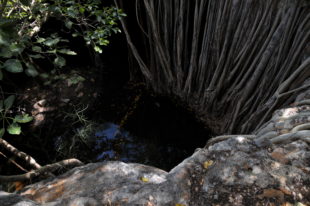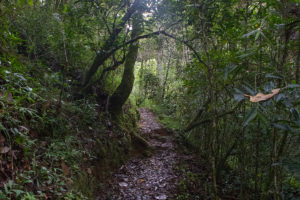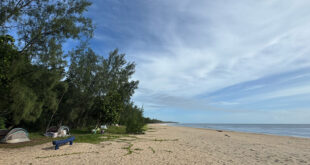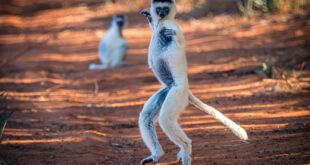Many myths and legends surround the Kalanoro, the small forest spirits of Madagascar. The ethnic groups of the Betsimisaraka, the Sakalava, and the Bara are said to be early humans similar to the legendary Vazimba. The Tanala call them Fahasivy. Kalanoro is particularly small, not even one meter tall. Despite their small size, they are unusually strong. Kalanoro wear their long hair not only on their heads but all over their bodies. They give them great magical abilities. The Kalanoro’s eyes are said to glow red in the dark and look terribly grim. Their fingernails are long, their hands are curved, and there are said to be only three toes on their feet, pointing backward. This makes it very difficult to follow a Kalanoro trail: You always run after her in the wrong direction.
Even today, the Kalanoro are said to live on Madagascar – hidden deep in the forest, safe from the prying eyes of man. But they are also said to live in caves, according to the Antankarana and the Tsimihety, spread all over the island. Only at night do they occasionally come to the villages. Here they take a pot of honey, there a prickly pear. Most of the year, however, the mystical beings live on the fruits of the forest and the sea. Sometimes they are said to be seen frolicking in rivers and lakes during the rainy season. They have a special connection with nature, plants, and animals, especially crocodiles, eels, and snakes. The Kalanoro are shy of people and rarely show their faces. However, they love the warmth of a fireplace in the cold dry season. And like to be tempted to stop by a lonely fireplace. To modern people, the mighty forest creatures are invisible. It is said that a Kalanoro only becomes visible when it has fingers or toes trapped and stuck under boulders.

Among many Malagasy, there is an idea that the Kalanoro lure children away from villages. In order to get the children back, the parents have to do certain things or offer them to the forest spirits, for example, rice or rum. What exactly it is about or what the parents have to do is requested from the Kalanoro with the help of a medium. The medium can be a man or a woman, into whom the spirit of the Kalanoro drives in, hidden by a cloth. In a high, childlike voice, the medium then speaks as the Kalanoro and conveys their demands. If the parents have complied with the Kalanoro’s wishes, they get their children back, usually in a cave. Several of these incidents are said to have occurred in the Andoboara cave in Ankarana National Park.
Also, a medium is needed if you want to make the forest spirits kind or apologize for the injury of a local fady. The Kalanoro can also help with infertility and the selection of appropriate medicinal herbs against diseases. Dogs are not allowed to be present during an invocation. They can see the forest spirits and keep them from showing themselves to people through the medium. For those who do not have a medium available, the Kalanoro can appear in dreams and give good advice. Some Betsileo believe that the Kalanoro steal infants and replace them with their own kind, or put curses on the children to stop their growth. Accordingly, people of small stature are often referred to as “children of the Kalanoro.”
Many adventurers have claimed to have seen living Kalanoro. In 1889, members of the Royal Geographical Society London are said to have even captured a Kalanoro on Madagascar. However, if you search the archives of the society, you do not even find a note about it. It seems to be an urban legend. In 1924, American politician and adventurer Chase Salmon Osborn reported seeing a pair of Kalanoro having sex. He could not provide proof of his sighting.

Scientists suspect that the legend of the Kalanoro may have a very real origin. Extinct giant lemurs like Hadropithecus stenognathus, Archaeolemur majori, or Archaeolemur edwardsi could have been the model for the mysterious creatures. They lived on the ground and were much larger than today’s Indris. So these lemurs could well have been mistaken for very human creatures.
Incidentally, similar forest creatures exist on the islands of Southeast Asia, where the first humans came from on Madagascar. In Sumatra in Indonesia, people repeatedly describe the existence of small, hairy Orang Pendek. Very similar creatures are known from the Solomon Islands southeast of New Guinea, all of which are said to be small and particularly hairy. On the island Guadalcanal people know the Mumulou, on the island Makira the Kakamora, on the island Maramasike the Moka, Mola, or Mumu. From the Congo – from the African mainland – there are sightings of the Kakundakari. Whether they are really mythical creatures like the trolls in Europe or perhaps early humans like Homo floresiensis in Indonesia is not yet clear today. With the Kalanoro, Madagascar perhaps still preserves one of its many undiscovered secrets.
 MADAMAGAZINE Your Magazine about Madagascar
MADAMAGAZINE Your Magazine about Madagascar




